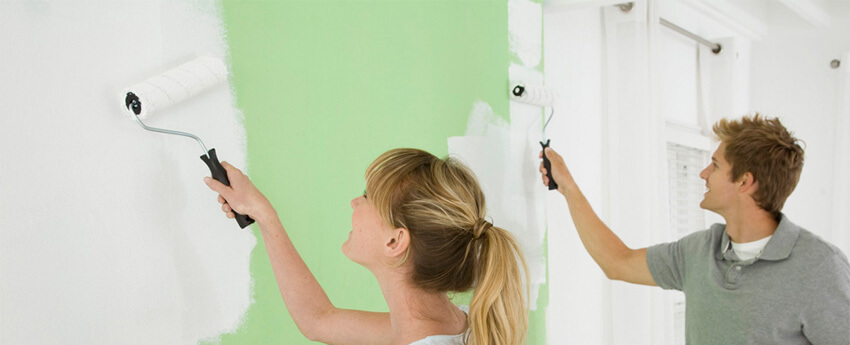
To become a professional painter and decorator, you will need to enjoy the hands-on, everyday work and have a keen eye for detail. Stamina and a good sense of balance can be important too, as you may be climbing ladders and lifting tins of paint. Painters and decorators use a variety of materials like varnish, paint, filler, plaster and sealant to cover and protect walls and other surface.
A painter and decorator work in the commercial and public sectors and are responsible for the external and internal appearance of a building and its protection from water, rust, mold and insects. There is a direct relationship between the nature and quality of the service required and the payment made by the client. Therefore the painter and decorator have a continuing accountability to work professionally and interactively with the client in order to give satisfaction and thus maintain and grow the business. Painting and decorating is closely connected with other parts of the construction industry, and there are merchandises that support it.
The painter and decorator work internally and externally in extremely various situations, for instance in organizations, industrial facilities, schools, hotels, the homes of customers and on building destinations in every climate condition. He or she may offer a scope of administrations, including interpreting customer prerequisites/drawings, advising on outlines/hues, painting, splashing, ornamental coatings, decorating, overlaying and sign writing to high standard.
Work organization and self-administration, correspondence and interpersonal skills, critical thinking, creativity, development, imagination, and the capacity to get ready surfaces altogether with fastidious care and work precisely are the widespread traits of the remarkable painter and decorator. In a versatile work showcase, the painter and decorator may work in groups, or alone, or in both now and again. And so on the structure of the work, the trained and experienced painter and decorator takes on a high level of personal responsibility and autonomy. From deliberately deciding the necessities of the customer, working securely and neatly, outstanding arranging and planning, accuracy and tender loving care to the fine plating of articles and completing of furniture, each procedure matters and mix-ups are to a great extent irreversible and expensive.
Painter and decorator Duties
The professional painters work for construction companies, contractors or building management corporations and may paint houses, business structures or bridges.
Professional painters begin by preparing surfaces for painting. This may oblige by, filling holes, removing old paint and washing walls. Sandpaper, wire brushes, scrapers and abrasive blasting may be used to prepare a surface. Holes and pieces are filled with grayish-yellow paste, plaster or caulk. Painter experts must also make sure that surfaces are not susceptible to moisture by sealing cracks and corners where building materials meet.
Professional painters must have a keen understanding of color theory. While color selection is eventually up to the customer, painters must be able to advise clients and understand by what means to construct the appearance their customers pursue. They may possibly use varnish, oil or paint additives to derive specific colors and textures. They may also use special techniques to provide decorative and artificial textures. These textures often require the use of washes, glazes and layering. Professional painters may also use techniques such as sponging, distressing, and stippling and color blocking to create effects for their clients.
In addition to painting, independent contractors have business responsibilities that they must manage. Professional painters need to market themselves to produce business and manage finances. They must quote job rates for customers and handle billing and invoicing. Professional painters must use first class products properly in order to have good outcomes. They must ensure that customers are satisfied with the final outcome and remedy any discrepancies. When employing others, they need to make sure that their employees are appropriately trained and paid. Eventually, they are responsible for job site safety and the quality of the work completed by all staff.
What’s the painting and decorating really like?
This career is a transforming profession that the work feels like an episode from a home renovation television program. It’s like coming into residential places and thinking new better and unique designs. Decorating is another way to display your personality and to make a space that really feels like you and that you can share with your friends when come to visit just see your designs, outcomes of your work.
Having an understanding of surfaces, and the material’s characteristics with the ability of not only identifying faults but knowing the causes, prevention and being able to resolve them are qualities of a well-trained tradesman. Beside with patience to focus on untiring preparation and the concentration to achieve the final result. You need to have a certain amount of pleasure in the job to gain the finishing touch, and encouraging comments received at the end make it seem worthwhile. Painting and Decorating is one of the most rewarding skills to get in to. On construction jobs, we’re the last people to go into the property – so our finishing touches leave it looking fabulous!
“Seeing people’s faces and their reactions at the end gives you a feeling of being appreciated.” – Sereena Roberts
References
https://www.plotr.co.uk/careers/painter-and-decorator/overview/
https://www.worldskills.org/what/career/skills-explained/construction-and-building-technology/painting-and-decorating/
https://www.careers.govt.nz/jobs-database/construction-and-infrastructure/construction/painter-and-decorator/
http://study.com/articles/Professional_Painter_Job_Description_Duties_and_Responsibilities.html
https://en.wikipedia.org/wiki/House_painter_and_decorator
https://sherwood.edu.au/courses/cpc30611-certificate-iii-in-painting-and-decorating/
http://www.guildmc.com/consumer-advice/why-choose-a-professional-painter-and-decorator.aspx


Recent Comments